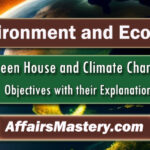Set 9 | Important Greenhouse Effect and Climate Change MCQs
Important Greenhouse Effect and Climate Change MCQs. Greenhouse Effect and Climate Change plays a crucial role within the broader field of environment and ecology. It serves as a foundational concept for achieving success in competitive exams such as Civil Services, State exams, SSC, Railways, Banking, and more. Mastering these subjects offers a unique advantage, allowing you to gain invaluable insights into the country’s environmental legacy. With a focus on Environment, Biodiversity, and Ecology, this knowledge not only sharpens your competitive edge but also equips you to excel in these challenging exams.
| MCQs on Greenhouse Effect and Climate Change – Objective Questions and Answers |

Q81. Consider the following agricultural practices (I.A.S. (Pre) 2012)
- Contour bunding
- Relay cropping
- Zero tillage
In the context of global climate change, which of the above helps/help in carbon sequestration/storage in the soil?
[A] 1 and 2
[B] Only 3
[C] 1, 2 and 3
[D] None of these
View Explanation
Correct Answer is C.
- Any method which helps the soil to retain more organic matter so that it may work as an effective Carbon sink would be helpful in Carbon sequestration or storage.
- Contour bunding is one of the extensively used soil and water conservation technique in several rainfed areas. Contour bunding is a Mechanical measure which minimizes the soil erosion. Relay cropping means that a new crop is planted or sown before the previous one is harvested.
- This can provide advantages for both crops as one of them may provide nitrogen, shade, support or may discourage pests. The obvious benefit of Relay cropping is soil conservation.
- Zero tillage is also based on the premise of soil conservation, the basic premise is to minimize the disturbances to the soil leading to an increase in retention of water, nutrients and topsoil itself.
- Zero tillage has carbon sequestration potential through storage of soil organic matter in the soil of crop fields. Thus all the three help in carbon sequestration.
Q82. The United Nations Framework Convention on Climate Change (UNFCCC) is an international treaty drawn at: (I.A.S. (Pre) 2010)
[A] United Nations Conference on the Human Environment, Stockholm, 1972
[B] UN Conference on Environment and Development, Rio-de-Janeiro, 1992
[C] World Summit on Sustainable Development, Johannesburg, 2002
[D] UN Climate Change Conference, Copenhagen, 2009
View Explanation
Correct Answer is B.
- The United Nations Framework Convention on Climate Change (UNFCCC) is an international environmental treaty adopted at the United Nations Conference on Environment and Development (UNCED), informally known as the Earth Summit, held in Rio-de-Janeiro from 3 to 14 June, 1992.
Q83. ‘Intended Nationally Determined Contribution’ some time seen in news refers to – (I.A.S. (Pre) 2016)
[A] A promise made by European countries for rehabilitation of refugees from Middle east.
[B] World Action Plan to deal with climate change
[C] Equity shareholding of member countries in AIIB
[D] World action plan for sustainable development goals.
View Explanation
Correct Answer is B.
- Countries of the world adopted a historic international climate agreement at the U.N. framework convention on Climate Change Conference of Parties (COP21) in Paris in December 2015. Countries publicly outlined post -2020 climate action they intended to take under this agreement. This was known as Intended Nationally Determined Contribution (INDCs).
Q84. Which of the following statements is incorrect for ‘Green Climate Fund” (GCF)? (U.P.P.C.S. (Mains) 2013)
[A] It was established in the Durban Conference on Climate change.
[B] It would support programs and policies in developing nations.
[C] The developed nations would provide the fund.
[D] The fund will start operating from, 2014.
View Explanation
Correct Answer is A.
- Green Climate Fund (GCF) was formally established during the 2010 United Nations Climate Change Conference in Cancun, Mexico. It is a fund within the framework of the UNFCCC founded as a mechanism to assist developing countries in adaptation and mitigation practices to counter climate change.
- The GCF is based in the New Songdo district of Incheon, South Korea. It is intended to be the centrepiece of efforts to raise climate finance of $ 100 billion a year by 2020.
Q85. Which of the following statements regarding the ‘Green Climate Fund’ is/are correct? (I.A.S. (Pre) 2015)
- It is intended to assist the developing countries in adaptation and mitigation practices to counter climate change.
- It is founded under the aegis of UNEP, OECD, Asian Development Bank and World Bank.
Select the correct answer using codes given below:
[A] 1 only
[B] 2 only
[C] Both 1 and 2
[D] Neither 1 nor 2
View Explanation
Correct Answer is A.
- Green Climate Fund (GCF) was founded as a mechanism to assist developing countries in adaptation and mitigation practices to counter climate change. The fund is governed by GCF Board. The board consists of 24 members.
Q86. Which one of the following countries is the first country in the world to propose a carbon tax for its people to address global warming? (I.A.S. (Pre) 2006)
[A] Australia
[B] Germany
[C] Japan
[D] New Zealand
View Explanation
Correct Answer is D.
- A Carbon Tax is a fee intended to make users of fossil fuels pay for climate damage by their fuel use whereas Sweden, Finland, the Netherlands and Norway have already introduced Carbon Tax. New Zealand, in 2005, introduced for the first time, a Carbon Tax to address global warming.
Q87. With reference to Deep Carbon Observatory (DCO) which of the following statements is/are correct? (U.P.P.C.S. (Pre) 2019)
- It is a Global Research Programme to outreach role of Carbon on Earth.
- It conducts field observations of deep microbial ecosystem.
Select the correct answer using codes given below:
[A] 1 only
[B] 2 only
[C] Both 1 and 2
[D] Neither 1 nor 2
View Explanation
Correct Answer is C.
The Deep Carbon Observatory (DCO) was a global scientific initiative comprising over 1,000 researchers who embarked on a decade-long mission (2009-2019) to investigate the quantities, movements, forms, and origins of carbon within Earth’s depths. DCO’s research was organized into four thematic communities:
- Extreme Physics and Chemistry
Focused on understanding the physical and chemical behavior of carbon under extreme conditions, such as those in Earth’s deep interior and other planetary environments. - Reservoirs and Fluxes
Aimed at identifying deep carbon reservoirs, studying carbon movement between them, and evaluating Earth’s overall carbon budget. - Deep Energy
Explored the production and rates of abiogenic hydrocarbons and other organic compounds in Earth’s crust and mantle over geological timescales. - Deep Life
Investigated the diversity, distribution, and activities of microbial and viral life forms in Earth’s deep biosphere.
This interdisciplinary effort provided transformative insights into the role of carbon in Earth’s systems, with implications for understanding planetary processes and life in extreme environments.
Q88. Due to their extensive rice cultivation, some regions may be contributing to global warming. To what possible reason/reasons is/are this attributable? (I.A.S. (Pre) 2010)
- The anaerobic conditions associated with rice cultivation cause the emission of methane.
- When nitrogen-based fertilizers are used, nitrous oxide is emitted from the cultivated soil.
Which of the statements given above is/are correct?
[A] 1 only
[B] 2 only
[C] Both 1 and 2
[D] Neither 1 nor 2
View Explanation
Correct Answer is C.
- The anaerobic conditions associated with rice cultivation cause the emission of methane. When nitrogen-based fertilizers are used, nitrous oxide is emitted from the cultivated soil. Hence both statements given above are correct.
Q89. Which of the following statements are true regarding the members of the Asia Pacific Partnership? (U.P.P.C.S. (Mains) 2005)
- Their population account to 45% of the world’s population.
- They consume the world’s 48% of energy.
- They contribute nearly 48% of the world’s greenhouse gasses.
- They intend to support the Kyoto Protocol.
Select the correct answer from codes given below: Codes :
[A] 1 and 2 only
[B] 1, 2 and 3 only
[C] 2, 3 and 4 only
[D] All of the above
View Explanation
Correct Answer is C.
- The population of Asia Pacific Partnership countries is 41% of the world’s population. They consume the world’s 48% of energy and contribute nearly 48% of the world’s greenhouse gases. They intend to support the Kyoto Protocol however some of the countries have not ratified it.
Related articles:
- Set 1 | Important Greenhouse Effect and Climate Change MCQs
- Set 2 | Important Greenhouse Effect and Climate Change MCQs
- Set 3 | Important Greenhouse Effect and Climate Change MCQs
- Set 4 | Important Greenhouse Effect and Climate Change MCQs
- Set 5 | Important Greenhouse Effect and Climate Change MCQs
- Set 6 | Important Greenhouse Effect and Climate Change MCQs
- Set 7 | Important Greenhouse Effect and Climate Change MCQs
- Set 8 | Important Greenhouse Effect and Climate Change MCQs



